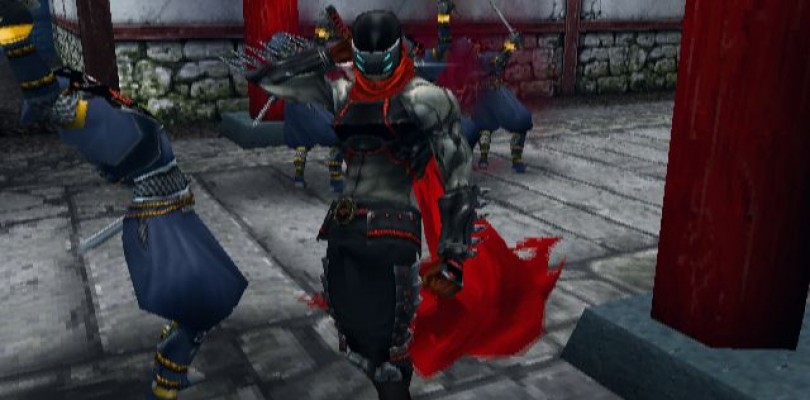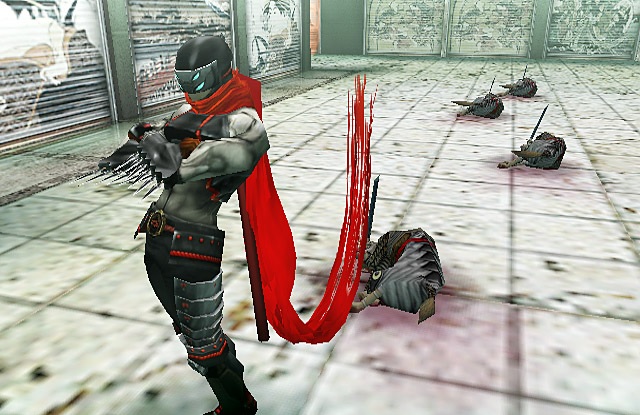This article is part of PS2 Week, a full week celebrating the 2000 PlayStation 2 console. To see other articles, go here.
///
Shinobi (2002) begins with a cliché. Two honorable ninja warriors, a master and a student, face off in a duel. The winner will take a position as the leader of his clan. The other will die. Off to the side, a female member of the clan complains to an elder: Why does it have to be this way? “This is something they have to do,” he replies. Of course he does.
Shinobi exists firmly in the cliché action movie world, where hard and irrationally grumpy men fight over poorly defined concepts of honor, all in keeping with rules that no one in their right mind would adhere to. It is, in short, excellently and fearlessly cheesy, committing to its own absurd premises in a way that only the most pulpy entertainment can.
When the protagonist, Hotsuma, begins the game proper, jumping from rooftop to rooftop in modern Tokyo wearing a Metal Gear Solid-style stealth bodysuit and Batman gauntlets, it’s immediately endearing and believable. I mean, what else would he be wearing?

When I was a kid, I told stories with my action figures. I self-consciously emulated my favorite media: shonen anime (intended for young boys), Power Rangers, American superheroes, and whatever snippets of action movies my parents let me get away with seeing. They were infinitely remixable improvised fanfictions, set on the stage of my wooden toy box. I’d act out scenes I’d watched, adding my own flair and imagery, conjuring up reasons for Spider-Man to fight Venom ad infinitum. It was here that I first learned that I loved telling stories. It was also where I first understood the thrill of participating in the particular type of storytelling that hero-based action media provides.
Heroic violence offers a profound but ill-defined sense of mystique. It’s an awareness of being involved with great people doing superhuman things, whether it’s Jack Bauer saving the country in the nick of time, or Zatoichi the “Blind Swordsman” conquering impossible odds with a grace and aplomb that no sighted warrior could ever hope to match. It’s a sense of cool. Cool that comes in the knowing that I could never be as exceptional or strong as this character. I could never do what they do. But knowing that they can do it is thrilling.
“Cool” is a concept not broached much in serious critical talk, but it’s essential to understanding this type of media. It especially seems relevant in videogames, a medium which strives to capture the same participatory thrill of my childhood dramas. Cool is the cousin of empowerment, after all. The basic power fantasy of many videogames bleeds into the fantasy of cool-guy mystique set up in heroic violence media. It’s not just that you can beat the boss. It’s that beating the boss can be a performance, a virtuous theater of heroic bloodshed.
This is the power of Shinobi. Situated at the middle of the three-dimensional reimagining of action videogames that would eventually birth such bombastic, mystique-filled games as Bayonetta (2009), Shinobi has a pure dedication to delivering on the fantasy of action-movie cool. It does this in a novel and direct way; by directly translating the tropes of heroic violence films into its gameplay in a manner that still transfixes.
Core to Shinobi‘s action is a simple, repeated maneuver. You’ve seen it, I’m sure, in some action film or anime. It’s iconic, and Shinobi is geared around tapping into that particular iconicism.

It goes like this: The sword-wielding hero attacks with a running leap, his weapon slicing through the air like a flash of light. The viewer doesn’t see the weapon connect. They just feel it, through deft cinematic cuts and a manipulation of lighting and sound. They feel it, and then the hero lands, crouched, sheathing her sword. Her foe stands still for a moment, stunned, and the audience has a chance to wonder: Did the steel connect? Perhaps the enemy gloats, thinking they’ve won. There’s a long, expectant pause.
Then, as if physics needed a moment to catch up, it happens. A slide of skin against skin, or a trickle of blood from a wound, molecules thick. The enemy is cut, and falls. The hero doesn’t even watch.
Combat in Shinobi is designed to conjure that moment to mind in every encounter. Most regular enemies die in just a few hits, making it easy, once you get the hang of it, to cut through them in seconds each. When an enemy dies, they don’t die immediately. They freeze, as if in stasis. This gives the player an opportunity to chain kills, jumping and dashing between multiple assailants, trying to kill everyone on screen before an invisible timer ticks down. When that timer finishes, all the frozen enemies die at once, blood and death rattles covering the game space. If the player is able to kill all of the enemies in that timeframe, this occurs as a short finishing cutscene.
Outside of that one conceit, the rest of the game is a bit thin and clunky—mostly basic running and jumping with a camera that, as is characteristic for the era, seems intent on fighting the player every step of the way. But the rest of the game doesn’t matter much, either. That core conceit is everything Shinobi needed to be. It elevates random encounters to violent theater, one that offers the mystique and ineffable cool of its absurd action movie ninja protagonist to the player, to hold it for just a time. To perform it as frequently—and as elegantly—as they please.
When videogames went from two to three dimensions, film opened up as a wellspring of influence. The era of the Nintendo 64 and the original PlayStation were largely defined by trying to adapt the spatial and narrative logic of those media to videogames, with mixed and muddled results. By the time of the PlayStation 2, an early vocabulary of games-via-film had been established. Short movies, cutscenes, were regularly used to distribute narrative, often aping the work of big-box Hollywood films with varying levels of success. The viewpoint with which we watch characters in 3D space was called a camera, after the literal camera held by Lakitu on a fishing rod establishing the premise in Super Mario 64.

With that vocabulary established, games in the second generation of 3D-capable consoles tried to better understand how to reintroduce elegance and grace into play. Many of the types of play that succeed in 2D look silly, or unrealistic, when realized in 3D. Film, again, was a powerful influence here, from the Black Hawk Down (2001) military fetishism of Metal Gear Solid 2 (2001) to the increasing reliance on action movie mystique in games like Shinobi and its near predecessor, Devil May Cry (2001). The latter is considered by history to be more influential, cementing the legacy of kinetic cool that would become the modern “character action” game (see, again, Bayonetta.)
But Shinobi, in terms of grafting filmic heroic violence into its mechanics, leverages a type of success that Devil May Cry doesn’t. It focuses on one bit of that mystique and chisels it into simple perfection. Pure Bloodshed Theater. Just like I’d always wanted.
